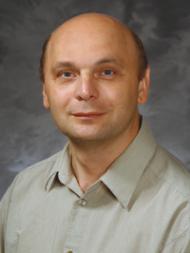Researchers forge primitive human leukemia cells in lab
Rogue stem cells are at the root of all leukemias.
Chronic myeloid leukemia (CML), a family of cancers that affect blood and bone marrow, is treatable in many instances. But the therapies used to keep the cancer in check have no effect on the primitive stem cells, also known as leukemia stem cells, that cause the disease in the first place — leaving patients susceptible to a relapse if they go off their meds.
Now, using cells from a patient with CML, researchers at the University of Wisconsin–Madison have found the recipe to generate cells with properties of primitive human leukemia cells in the lab. The work establishes a potent model for studying CML stem cells and identifying new drugs that could potentially provide better treatment options for leukemia.

Igor Slukvin
“Treatment doesn’t eliminate the stem cells that cause chronic myeloid leukemia,” explains Igor Slukvin, a UW–Madison professor of pathology and laboratory medicine and an expert on stem cells and human blood. “We know we can treat CML, but we can’t cure it. The stem cells persist.”
Slukvin and his collaborators report their work online in the journal Stem Cell Research. By genetically reprogramming the patient’s bone marrow cells, the Wisconsin group was able to turn back the developmental clock and make all-purpose induced pluripotent stem cells (iPSCs), which capture the underlying genetic alterations driving the leukemia. Directing the induced primitive CML cells to become early blood cells, researchers were able to generate cells that share many properties of leukemia stem cells, including increased long-term survival and proliferation as well as innate resistance to drugs.
The drugs now used to treat CML are known as tyrosine kinase inhibitors; they work by stopping the progression and proliferation of the cancer cells emanating from the bone marrow. Though these drugs are very effective, patients risk relapse if they stop taking the medication. Moreover, in some patients the leukemia cells develop resistance to the drug, making it less effective.
The ability to make leukemia stem cells in the lab using reprogrammed adult bone marrow cells from patients will give scientists a new way to explore the development and progression of the disease in a laboratory dish. Currently, only mouse models of leukemia stem cells are available in the lab.
The advent of a human cell model opens the door to exploring the differences in how the disease manifests itself within different people. “The induced cells capture the genetic abnormality of the individual patient,” says Slukvin, creating the potential for more personalized treatment of the disease.
In addition, the new cell model creates a path to capture the genetic variations of the disease as it manifests itself in individual patients. Because iPSCs arise from a single cell, the selection of individual cloned iPSC cells makes it possible to capture the diversity of genetic alterations within individual stem cells and study their effects.
Because the disease transitions through chronic, accelerated and acute phases in patients, the new model may also let scientists study the progression of leukemia in the lab.
“If we make iPSCs from stored patient samples collected at different stages of diseases,” notes Slukvin, “we can produce from these iPSCs primitive leukemia cells that capture different stages of leukemia progression.”
An important potential application is that the lab-created human stem cells, like other types of synthesized stem cells or their derivatives, can also be used to learn more about leukemia stem cell survival factors and develop high-throughput drug screens where chemical compounds can be tested for efficacy and safety as potential drug candidates. Slukvin and his team, in fact, used the new system to discover a novel primitive leukemia cell survival factor, a protein known as olfactomedin 4.
Using drugs or antibodies to target the protein, which helps the primitive CML cells survive, may open an avenue to clear the leukemia and potentially cure the disease, although much work remains to be done to achieve such an outcome.
In addition to Slukvin, who holds appointments in the UW School of Medicine and Public Health and at the Wisconsin National Primate Research Center, the new study was performed by Kran Suknuntha and David Yang of UW–Madison; Yuki Ishii and Jean Y.J. Yang of the Moores Cancer Center at the University of California, San Diego; Lihong Tao and Kejin Hu of the Wisconsin National Primate Research Center; and Brian McIntosh, Scott Swanson, Ron Stewart and James Thomson of the Morgridge Institute for Research at UW–Madison.



